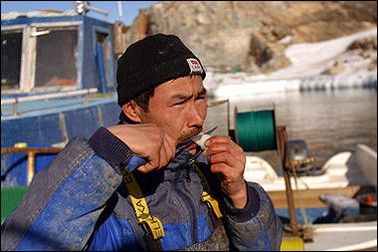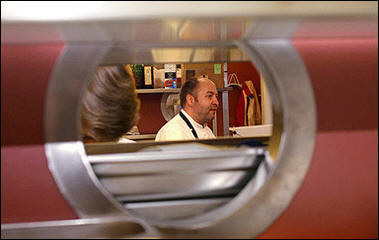Whale carpaccio, reindeer filet: Greenland’s contemporary cuisine
April 7, 2006 - Agence France Presse

ILULISSAT, Greenland (AFP) - With his boat moored to the ice that creeps into this small city’s harbor, a longline fisherman provides a perfect example of the state of contemporary cuisine in Greenland.
At about noon, he drops the hooks he has been baiting, hops back onto the ice and pulls a freshly caught halibut from a plastic bin.
Taking the fish, he cuts out a few bite-sized snacks so fresh, sushi chefs would be wasabi-green with envy.
Although chefs here are forced to make the best out of what they’ve got with only one or two shipments a week, Greenland is not the gastronomic wasteland many might expect.
As fast as nature, tradition and shipping lanes will allow, a small group of chefs is exploring the boundaries, searching out their own versions of perfection while highlighting native products.
At a restaurant unofficially known as “The Rowing Club” on the edge of Kangerlussuaq, chef Kim Ernst dry ages the musk ox he buys from local hunters for more than 20 days.
 Chef Michael Mortensen is seen working through a kitchen portal in the restaurant Ulo at Greenland’s Hotel Arctic in Ilulissat.(AFP/File/Joe Ray)
Chef Michael Mortensen is seen working through a kitchen portal in the restaurant Ulo at Greenland’s Hotel Arctic in Ilulissat.(AFP/File/Joe Ray)A typical appetizer might consist of lightly-smoked reindeer meat, served next to tiny local shrimp and sauteed scallops. Though it’s a simple presentation, each product shines on its own.
Ernst maintains that the best way to get the flavor of musk ox is to cook the steaks rare—much like in the best French restaurants.
“When it’s well-done,” he said, referring to a typical local dish, “it’s like rubber.”
Despite his remote location on the edge of a lake so pure that it provides drinking water for the town below, his work is catching on, and Ernst and his three-person crew welcome 300 to 400 guests a week.
Up the west coast in Ilulissat, home of a UNESCO-classified fjord, classical training and local ingredients come into play.
Although the ingredients can seem odd at first to outsiders, the results can be spectacular such as at the new Restaurant Mamartut, run by Danish chef Kim Pederson.
Whale carpaccio with capers, angelica and parmesan shavings, all served with a sparkling French cremant, or mattaq, deep fried whale skin over a sorbet made with the lemon-flavoured ledum groenlandicum plant are some of his spectacular and unique starters.
Perched on a hillside above town is Hotel Arctic, whose Airstream trailer-esqe igloos are reported to be a favorite refuge for Icelandic singer, Bjork.
With its dramatic backdrop of icebergs, it is also the setting for chef Michael Mortensen’s Restaurant Ulo.
One of the chefs involved in cooking the food seen in the film “Babette’s Feast,” Mortensen brings his mastery of European techniques to some of the best presentations of Greenland’s native products.
His halibut with snow crab starter is reminiscent of perfect New England chowder, while his reindeer filet in a blackberry sauce is a stunning example of a local products cooked to perfection.
Although good wine is a rare and expensive commodity here, the halibut is perfectly accompanied by a 1999 Riesling and the reindeer nicely balanced by a 2002 Nebbiolo.
Whatever the restaurant, many a meal here is rounded out by Greenlandic coffee, a drink that may be the reason behind Rudolph’s red nose.
Although it comes in varied guises, it tends to be a glass of whisky and Kahlua heated over a flame, followed by coffee (representing the sea), whipped cream (the icebergs), and flaming Grand Marnier, poured theatrically from a great height (the northern lights).
Working in Greenland is a bit of a tight-rope act for Mortensen. “I don’t know what I can get tomorrow or next week,” he said, “but that’s the condition of being here.”
But four years into his job, he still loves the restaurant’s sweeping views and the relative lack of stress.
“I’m 43. I cannot work 12, 13, 14 (hour days) like chefs in London, Copenhagen and Paris,” he said. “They’re finished when they’re 40. I still have the heart for the food.”
For Mortensen, the key seems to lie with the ingredients. “The difference between Ilulissat and Denmark is fish, reindeer, musk ox and lamb.
“It’s the best you can have.”